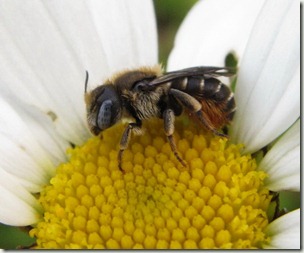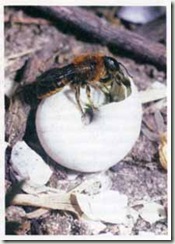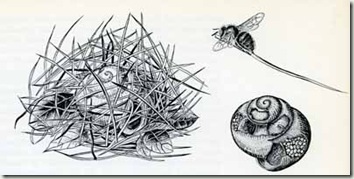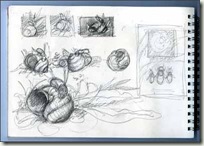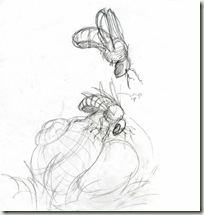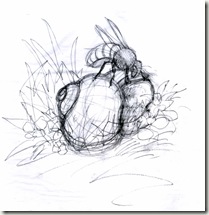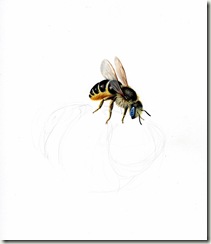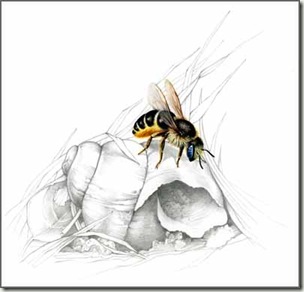Yes, you knew all along that yesterday’s snail shells were not just random sketches but really bee related..didn’t you? I first came across these astonishing little bees when reading “Animal Architecture” by Karl Von Frisch.
In his fascinating book he describes how the bee will search for a suitable empty snail shell, provision it with bee bread, lay her egg, then, leaving enough space for the growing bee, seal it with a partition of chewed up leaves, (there are sometimes more than one cell in each shell).
She then fills the remaining whorls with a fortifying layer of tiny stones finishing off with a final partition and some moss. She then carefully covers the shell with a tent of twigs and grass and chewed up leaves for extra camouflage.

This photo from “Bees of the World” by Christopher O’Toole and Anthony Raw, shows an Osmia bee finishing off her nest with a sliver of reinforcing snail shell.
There are some very nice accounts of people observing these industrious little bees, both past and present. Here is an extract from Frisch’s book accompanied by a really nice drawing which illustrates his observation.
“Once when I was out hunting insects, I made a swipe at an oddly flying, bizarre-looking creature. To my surprise all I found nothing in my net apart from a mason bee and a dry stalk. Having read about the tent building habits of of these bees I was intrigued. I released the bee and settled down to watch. After a while I was rewarded by seeing her return, riding on another piece of stalk like a witch on a broomstick.The heavy load slowed her down to such an extent that I just managed to keep her in sight as I ran and she herself guided me to her nest.
Another time I watched the same species nest building on a cow track in a mountain pasture. Here the stalks and twigs were all arranged toward the toe end of the cows footprints, a beautiful adaptation to local conditions. The speed of the building was amazing. One of the bees I watched was just making a partition for which she had collected bits of leaves from a nearby strawberry patch. She kept flying back and forth in a straight line between the plants and the nest” ‘

Jean Henri Fabre experimented with giving bees a choice of shell or hollow reed for nesting and concluded that they would only take the shell if the reed was not available possibly because it is more difficult to build a nest in a tapering spiral than in a tube of more or less constant dimensions.
The bees has to calculate that the size of the aperture will accommodate her developing offspring!
“Why, when I offer them simultaneously Snail-shells and reeds of a suitable size, do the old frequenters of the shells prefer the reeds, which in all probability have never before been utilized by their race? Most of them scorn the ancestral dwelling and enthusiastically accept my reeds. Some, it is true, take up their quarters in the Snail-shell; but even among these a goodly number refuse my new shells and return to their birth-place, the old Snail-shell, in order to utilize the family property, without much labour, at the cost of a few repairs. Whence, I ask, comes this general preference for the cylinder, never used hitherto? The answer can be only this: of two lodgings at her disposal the Osmia selects the one that provides a comfortable home at a minimum outlay. She economizes her strength when restoring an old nest; she economizes it when replacing the Snail-shell by the reed.”
There are lots of lovely observations about the snail shell bees in his writings..He describes the different Osmia and which shells they seem to prefer. Go to http://www.efabre.net… search, read, and share his delight. Walter Linsenmaier’s “Insects of the World” details how some bees move the shells to hiding places.
“ Taking firm hold of the ground with repeated bites they grasp the shell with their legs and haul it after them. Some apply plant paste to parts of the slippery shell enabling their feet to get a firm grip. A few species bury the shell in sandy soil, others protect it with a cover of interwoven pine needles… It is ever a new experience to observe how objectively and with what careful testing such bees work and how penetratingly thorough is their interest in their productions.”
(It is interesting that his illustration predated that of Frisch’s and is very similar and I would imaging that Turid Holldobler who drew the text illustrations for Frisch based her drawings on Linsenmaier’s.)
Whose Shell is This?
For a current, and wonderfully entertaining view of a snail shell bee investigating a shell go to Nico Vereecken’s short film here. Initially it seems that a bee arrives to find the shell already occupied by another but a bee comes back again and again, goes in and out of the shell and turns it over and over.
Watch for the uneasy encounter between the bee and the jumping spider, who is playing king of the castle, and the passing enormous elegant ant!
Nick has built an incredible photographic bee resource which you can find on Flickr here.
Thanks so much to Alan at Norwegica’s Aculeate Blog for first linking to this film!!
The Painting
There are several UK Osmia bees which use snail shells Osmia bicolor, Osmia aurulenta and the little Osmia spinulosa (10mm) which is the one I chose to paint.
Jeremy Early at “Nature Conservation Imaging” refers to them in his excellent “Downland Bees” page.
They seem to use a variety of shells so I went out snail shell hunting some time ago only to discover that there are not many land snails to be found here. I eventually found one I thought suitable and made some sketches and then built a little set complete with a tiny bee. (apologies to the very sensitive amongst you, but it’s one that was kindly sent to me).




Why did I choose this bee? For the very non scientific reason that it has beautiful blue eyes!

___________________________________________________
The Blue Eyed Osmia Spinulosa, considering the possibility of a new home…

Watercolour and pencil on Arches HP approx 8” x 8”
BLOG UPDATE .. May 19th 2010.
Great blog post on Osmia bicolour making her nest in a snailshell.. here: at Antje Schulte’s blog “Four Feet and More“
http://fourfeetandmore.blogspot.com/2010/05/osmia-bicolor-bee-that-nests-in-snail.html

